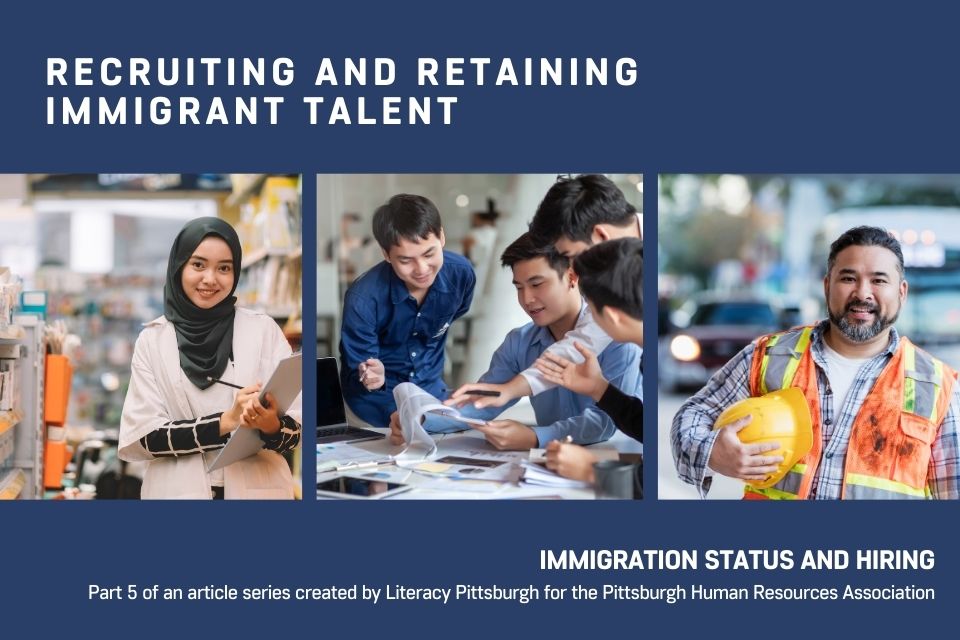
By Nicole Mannino Johnson, Director of Strategic Initiatives, Literacy Pittsburgh, njohnson@literacypittsburgh.org and
Allegra B. Elson, Director of Training and Development, Vibrant Pittsburgh, allegrae@vibrantpittsburgh.org
As of June 2024, there were 1.9 active online job advertisements for every unemployed worker in Allegheny County.1 Immigrant workers bring considerable talent to our region and help fill labor gaps across sectors. Immigrants in the City of Pittsburgh are 18.3% more likely to be of working age than their U.S.-born counterparts in the city.2 They also helped save or create 1,200 local manufacturing jobs that would have otherwise been eliminated or moved elsewhere in 2019.3
Immigration contributes to economic expansion rather than causing displacement. Immigrants are 21.8% more likely to be entrepreneurs than U.S.-born individuals.4 They add spending power, expand the market, and increase employment opportunities.
There is a solid case for hiring immigrant talent, but immigration status can be confusing. In this article, we’d like to shed light on how immigrants arrive in the United States and the statuses they can hold.
The Immigration and Nationality Act (INA) governs immigration law in the United States.
- Up to 675,000 permanent immigrant visas can be granted annually across various visa categories.
- In addition, U.S. citizens’ spouses, parents, and children under the age of 21 may be admitted with no limits.
- Each year, the president and Congress set the number of refugees that can be admitted to the United States through the U.S. Refugee Admissions Program.
- Non-immigrant visas can include temporary workers, international students, and tourists entering the country for a specified period of time. The latter two groups are not authorized to work in the United States.
- Some immigrants arrive through humanitarian protections such as asylum, Temporary Protected Status, and other programs that grant legal status.5
Individuals in these two broad categories are eligible to work in the United States:
Naturalized Citizens can earn this status in a few ways but are most likely individuals who have resided in the United States for at least five years, are age 18 or older, hold a green card, and can speak and read English. They have completed an interview with USCIS and attended a naturalization ceremony to be sworn in as a United States citizen.6
Lawful Permanent Residents are non-citizens who are allowed to live in the United States permanently. These individuals are often called "green card holders" because the U.S. Citizenship and Immigration Services (USCIS) grants them a permanent resident card as proof of their status.7
Lawful Permanent Residents can arrive in the United States in a variety of ways.
Non-immigrant visa Holders are individuals with a strong combination of job skills, education, and work experience who seek to live permanently in the U.S. through one of the various employment-based visas.8
Refugees are unable to return to their home countries because of a “well-founded fear of persecution” due to their race, social group, political opinion, religion, or national origin.9 Refugees apply for admission from outside of the United States, often from a “transition country” that is outside their home country. Refugees are eligible to work immediately upon admission to the United States.
Asylees are individuals already in the United States or arriving at a port of entry who are seeking protection based on persecution due to their race, social group, political opinion, religion, or national origin.10 At 150 days after submitting their asylum application, asylum seekers can apply for an Employment Authorization Document (EAD) to legally work. Individuals whose asylee application has been approved can live and work permanently in the United States.11
Humanitarian Parolees are those who are granted temporary admission to the U.S. based on urgent humanitarian need, such as needing protection from targeted or individualized harm.12 This status typically lasts for two years; then, they must adjust their status to live and work in the U.S. legally. Most parolees must apply for an Employment Authorization Document (EAD). However, Afghans/Ukrainians can work legally upon receiving parole.
Immigrants come to the United States in a variety of ways, but they all share a desire to contribute to our society and economy. They can help fill employment gaps, boost spending power, and create jobs through entrepreneurship.
This article is part five of a series by Literacy Pittsburgh with tips on hiring and retaining immigrant talent.
Literacy Pittsburgh offers free educational programs for adults and families in Allegheny County and Beaver County. Last year, the organization helped more than 4,000 people in the Greater Pittsburgh area improve their reading, writing, math, English language, digital literacy, and workplace skills. Adult literacy classes and tutoring move students from learning to earning and help them succeed as workers, parents, and neighbors. Learn more about their programs and opportunities to support their work at www.literacypittsburgh.org.
Vibrant Pittsburgh is a premier economic development organization dedicated to supporting the growth and economic competitiveness of Pittsburgh as the region’s central resource, spokesperson, and convener on workplace inclusion, equity, and diversity. Vibrant Pittsburgh’s mission is to accelerate the business community toward equitable, inclusive, and diverse workplaces, creating a future-forward region. Vibrant Pittsburgh envisions a future where Pittsburgh employers offer inclusive workplaces that foster prosperity and belonging, making them a top choice for people of all backgrounds. Learn more at www.vibrantpittsburgh.org
Sources
1https://www.partner4work.org/research/june-2024-labor-market-report/
3Ibid
4https://immigrationforum.org/article/immigrants-as-economic-contributors-immigrant-entrepreneurs/
5https://www.americanimmigrationcouncil.org/research/how-united-states-immigration-system-works
6https://www.uscis.gov/citizenship/learn-about-citizenship/citizenship-and-naturalization
7https://ohss.dhs.gov/topics/immigration/lawful-permanent-residents
9 https://www.uscis.gov/humanitarian/refugees-and-asylum/refugees
Literacy Pittsburgh (formerly Greater Pittsburgh Literacy Council) helps create better lives through learning. Recognized as a national leader in adult and family literacy, Literacy Pittsburgh is the largest provider of adult basic education in Allegheny and Beaver Counties. Last year, Literacy Pittsburgh helped more than 4,000 individuals acquire the skills needed to reach their fullest potential in life and participate productively in their communities. Literacy Pittsburgh provides free, personalized instruction in workforce readiness, high school diploma test preparation, digital literacy, English language learning, math, reading, and family literacy through one-to-one and small class instruction. Founded in 1982, it serves local adults through numerous neighborhood locations and its Downtown Pittsburgh Learning Center.


